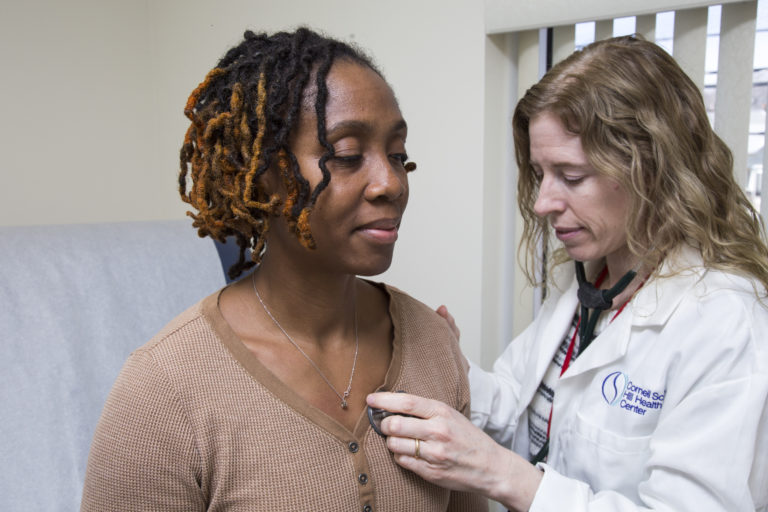Federally Qualified Community Health Centers (FQHCs) in Connecticut have expanded services, upped their staffing and renovated their facilities mostly due to increased revenue streams from the Affordable Care Act (ACA).
Connecticut and the 30 other states that opted for the ACA Medicaid expansion program have benefitted from billions of dollars in additional core grant funding, with Connecticut receiving $150.7 million from 2011 to 2016, according to a January report by the Congressional Research Service.
 Derek Torrellas Photo.
Derek Torrellas Photo.
Dr. Howard Smith gives Jacob Valasquez his six-month examination at the Southwest Community Health Center, Bridgeport.
Health centers in Connecticut used some of that funding to hire professionals to enroll thousands of residents in health insurance—residents who were previously uninsured and used the centers for their health care. Now the centers are serving about 70,000 more insured patients, mostly covered by Husky Health plans. The cost of treating uninsured patients has declined by about $10 million since 2012, according to Deb Polun, director of government affairs and media relations at the Community Health Center Association of Connecticut.
But the future financial stability of health centers is uncertain. The House passed the Republican-backed American Health Care Act – which would make a significant reduction in Medicaid funding and result in fewer people being insured. The measure’s fate in the Senate is unsure, as GOP senators meet behind closed doors to hammer out a health care reform bill. The President’s budget also includes deeps cuts in Medicaid.
Sophia Stone, 43, of Hartford relies on the HUSKY D coverage she’s had for 14 years, which covers her and her 13-year-old son. She fears it could suddenly be taken away. The single mother and teenager receive all their health care at Community Health Services Inc. in Hartford: physicals, eye exams, dental exams, ob-gyn visits and pharmacy services, all at no cost to Stone.
“I can’t even think about [Medicaid] going away because I don’t know what we would do,” said Stone, who works 25 hours a week at a small business with no employer-backed insurance available. “We definitely need it. If that goes away, I don’t have a 40-hour job so it’s hard for me to get insurance.” She would be unable to afford to purchase insurance through the state’s health insurance marketplace, she said.
Grants to FQHCs are also in jeopardy. Federal dollars known as “330 grants,” which FQHCs depend on, must be reauthorized by Congress before they expire at the end of September or centers will lose that money, said Katherine Yacavone, president and CEO of Bridgeport-based FQHC Southwest Community Health Center, which operates 18 sites.
The grants, named for Section 330 of the Public Health Service Act that created them, are disbursed by the Health Resources and Services Administration.
Even though the grants historically have had bipartisan support, centers still have to lobby heavily for them and there is no guarantee, Yacavone said. Among other things, that money pays the centers differentials when patients pay discounted fees for medical care, she said.
Also, on the state level, the budget is in flux. Any change in Medicaid requirements or decrease in coverage would likely lead to an increase in uninsured patients, which adds to health centers’ expenses since by law they can’t turn patients away due to inability to pay.
Southwest Community Health Center served 22,432 patients last year, about 60 percent of whom were on Medicaid. Roughly 18 percent of the center’s patients are uninsured, down from 23 percent before Medicaid was expanded.
Yacavone hopes that Congress will keep the ACA in place even though “we know it needs to be fixed.”
 Derek Torrellas Photo.
Derek Torrellas Photo.
Natalie Lourenco, physician assistant at the Cornell Scott-Hill Health Center, checks Latoya Armstrong’s heart.
“Continuation of the Affordable Care Act demonstrates the need for the federal government to ensure that eligible persons have access to health care—medical, dental and behavioral health services,” she said. “These services are essential to promote well-being, particularly among the nation’s low-income and vulnerable populations.”
At the Middletown-based Community Health Center Inc. (CHC), funding launched Project ECHO, an initiative that trains primary care providers to meet the needs of LGBTQ patients and others who may face barriers or stigmas. The program is in all 14 CHC sites.
Wanda Montalvo, associate director of the Weitzman Institute, the research center at CHC said the program gives many patients their first chance to be treated in a welcoming, non-judgmental setting.
Luna Hernandez credits Project ECHO with keeping her health on track. She still struggles with the physical effects of living on the streets as a teenager. But harder though has been her emotional battle with gender identity.
“I’m HIV positive and was finally able to connect with services,” said Hernandez, who is transgender. Hernandez described being kicked out of her house at age 13 because she was “different,” and of never receiving services she needed while struggling with her identity. She spent years living on the streets, grappling with drugs and thoughts of suicide. She finally enrolled in Project Echo in 2015.
“This program made sure everything was OK and that all my needs were being met, and that I can get help,” Hernandez said.
At the Cornell Scott-Hill Health Center, ACA funds led to additional behavioral health staff and services, particularly amid the opioid epidemic, as well as expanded dental services, said CEO Michael Taylor.
Patients who gained coverage under the ACA are “more engaged in care” than they were when they were uninsured, he said.
Of the roughly 37,000 patients the center sees annually, about 70 percent are on Medicaid, he added. The New Haven-based center is slated to open its 21st location, in the West Rock neighborhood of New Haven, this summer.
Repeal of the ACA “will most certainly have a financial impact on our organization,” Taylor said.
In Connecticut, the Medicaid expansion resulted in an increase in HUSKY D enrollees. That number has climbed in recent years, from 74,000 enrollees in July 2011 to 213,676 in December 2016, according to the state Department of Social Services (DSS). Connecticut’s overall Medicaid population also has swelled, from 450,377 enrollees in July 2009 to 764,106 in December 2016, according to DSS. In states that expanded Medicaid, individuals qualify for coverage based on their income alone; elsewhere eligibility is determined by a combination of factors.
In 2015, the most recent year for which data is available, 16 health centers served 350,055 patients, 62 percent were on Medicaid, according to the U.S. Health Resources & Services Administration.
Freelance writer Liz Seegert contributed to this story.
Share this Post












